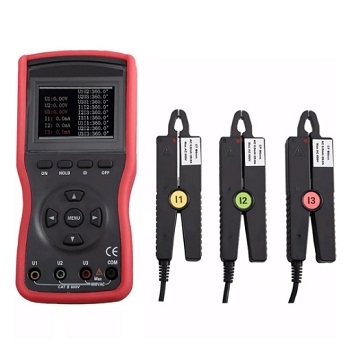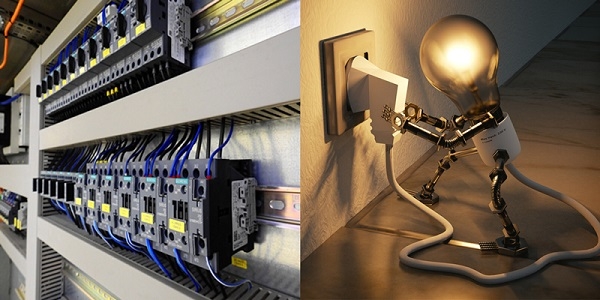A Volt-Amp Meter (VAM), often referred to as a Power Meter or VA Meter, is a measuring instrument used to monitor and display electrical parameters in an electrical circuit. It combines the measurement of both voltage (in volts) and current (in amperes) and provides information about power (in watts) and apparent power (in volt-amperes). Volt-amp meters are commonly used in electrical engineering and electronics to assess the electrical characteristics of a circuit or device. They are handy for understanding power consumption and evaluating the efficiency of electrical systems. This article will tell you more about the volt amp meter.
Primary Measurements and Components
- Voltage (Volts): A VAM measures the voltage level at a specific point in an electrical circuit. Voltage represents the electrical potential difference between two points and is typically measured in volts (V).
- Current (Amperes): It measures the electric current flowing through a circuit or a specific component, and it is typically measured in amperes (A).
- Power (Watts): By multiplying the voltage and current measurements (P=Vx I), the Volt-Amp Meter can calculate and display the real power in watts (W). This measurement indicates the actual power consumed or produced in the circuit.
- Apparent Power (Volt-Amperes): The Volt-Amp Meter can also measure apparent power, which is the product of voltage and current (S = V x I). Apparent power is expressed in volt-amperes (VA) and represents the total power flow in an AC circuit, taking into account both real power and reactive power. It is crucial in alternating current (AC) systems, where power factor becomes important.
- Power Factor: Some advanced VAMs include a power factor measurement, which indicates the ratio of real power (watts) to apparent power (volt-amperes). Power factor is essential in AC systems to determine how efficiently electrical power is being used.

Working Principle
- Volt amp meters work on the principle of Ohm's law. According to Ohm's law, current is equal to the ratio of voltage to resistance, which is I=U/R. The volt-amp meter calculates resistance by measuring current and voltage.
- The volt amp meters have an internal current stop and a voltage stop. To measure current, select the appropriate range for the current setting of the volt-ohmmeter and connect the probe to a series resistor in the circuit. According to Ohm's law, the passage of current through the series resistance produces a corresponding voltage signal in the current position of the voltammeter. By measuring this voltage signal, the volt amp meters can tell the amount of current in the circuit.
- To measure voltage, select the appropriate range for the voltage setting of the volt-amp meter and connect the pens to the two points in the circuit where the voltage is to be measured. The formula according to Ohm's law is U=IR. the voltmeter can get the magnitude of the voltage in the circuit by measuring the voltage between the two points of the circuit.
Common Applications
The versatility of Volt-Amp Meters makes them indispensable in various sectors, from everyday household applications to critical industrial processes, helping ensure the efficient and safe operation of electrical systems and devices. A wide variety of voltammeter options are available to you at sisco online shop.
- Electrical Maintenance and Troubleshooting
VAMs are frequently used by electricians and technicians to diagnose electrical problems, such as circuit overloads, short circuits, and voltage fluctuations. They help identify the root causes of issues and enable quick repairs. - Power Consumption Monitoring
VAMs are used in homes and businesses to monitor and manage energy consumption. They provide information on how much power is being used, helping consumers make informed decisions about energy usage and efficiency. - Quality Control in Manufacturing
In manufacturing and production environments, VAMs are used to ensure the quality and performance of electrical equipment. They help verify that machines and systems are operating within specified voltage and current parameters. - Industrial Process Control
VAMs are integrated into control systems to monitor and regulate electrical processes, ensuring they remain within safe and efficient operating conditions. - Data Center Power Monitoring
Data centers use VAMs to monitor power usage and ensure the stability of electrical systems that support servers and critical IT equipment. - Renewable Energy Systems
In solar and wind power installations, VAMs measure the output of renewable energy sources and assess the performance of inverters and converters. - Home Appliances and Electronics
Some appliances and electronic devices incorporate basic power meters to display energy usage to consumers and encourage energy conservation. - Electrical Load Balancing
VAMs are used in industrial settings to distribute electrical loads evenly and avoid overloading circuits or equipment.

- Electrical Testing and Calibration
In laboratories and calibration facilities, VAMs are used to calibrate and verify the accuracy of other instruments, ensuring the traceability of measurements. - Energy Efficiency Audits
Energy auditors use VAMs to assess the energy consumption of buildings and industrial facilities, identifying areas for improvement in energy efficiency. - Power Quality Analysis
VAMs can help diagnose and analyze power quality issues such as voltage sags, surges, harmonics, and frequency variations, which can impact sensitive electronic equipment. - Load Profiling
Utilities use VAMs for load profiling, analyzing and recording the electricity consumption patterns of customers to optimize grid management and billing. - Research and Development
Scientists and engineers use VAMs in research and development projects to measure power characteristics, analyze electrical parameters, and study electrical systems. - Educational and Training Tools
VAMs are used in educational settings to teach students about electrical circuits, measurements, and power concepts.
The versatility of Volt-Amp Meters makes them indispensable in various sectors, from everyday household applications to critical industrial processes, helping ensure the efficient and safe operation of electrical systems and devices.

